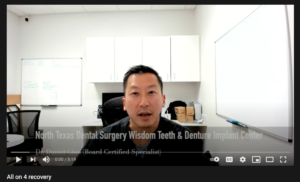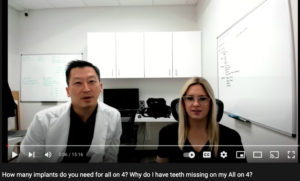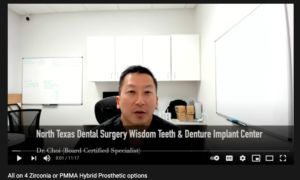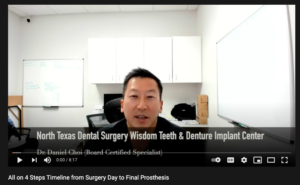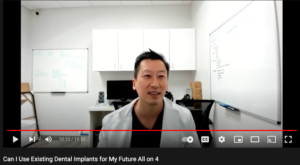CBCT 3D Scans and Dental Implant Sizing to Avoid Complications
Dental Implants
So lets assume you have all your teeth but are about to replace one due to a fracture, huge cavity, trauma, etc. You would just assume based off of what we just discussed that we place as long and wide of an implant as possible.
Two common anatomical limitations that limit how long of an implant you can place: Your sinuses and your inferior alveolar nerve.
Maxillary Sinuses
Your upper jaw bones have air filled cavities that are connected to your nasal passages.
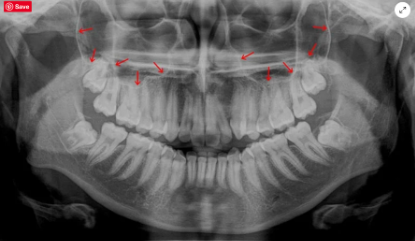
Upper Jaw Dental Implants
You want to bury your dental implant as deep as possible in your soft upper jaw bone, but if you have large sinuses, then we’re placing your implant in air because it’s a hollow cavity in your bone. Compare it to trying to secure 3 inches of a screw in the wall but the dry wall is only 1 inch thick.
Why does this matter? Your implant can fail eventually if your implant isn’t secured in enough bone. Also what if somebody tells you that you need to add more bone in this case via a sinus lift and have to pay thousands of dollars more? You would be able to tell by looking at your CBCT scan (3D Scan)
Lower Jaw Dental Implants
The inferior alveolar nerve is a major nerve that runs along your lower jaw. In the process of trying to place as long of an implant as possible, if your dentist drills into the nerve, you can suffer from permanent numbness of your nerve.
You will have numbness on the lip and chin area on the affected side. We can determine this distance of the nerve by again evaluating your CBCT scan (we will discuss this more in the implant complications video).
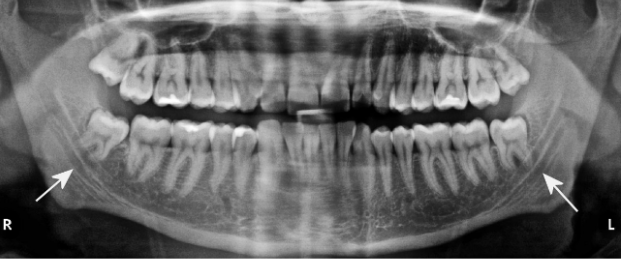
Dental Implant Sizes
Just like screws, they come in different lengths, widths, shapes and sizes. As mentioned in the previous slide, we want to place as long and wide of an implant as possible, BUT we don’t want to be in your sinus or your inferior alveolar nerve. How do we know ahead of time what size of an implant we can place?
Old Way of Placing Dental Implants
We used to have to make an incision in your gums to see how wide the bone is. In order to see what length implant we use, we used to take a 2D x-ray, start drilling, and then take another x-ray and see how far we were from the sinus or Inferior alveolar nerve.
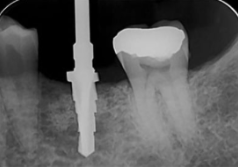
Placing dental implants had to rely on guessing and experience to see how far away the drill was from your sinuses and nerves.
The problem is that the traditional x-rays could give us a basic understanding of the height and width of a space where you wanted to place an implant.
Traditional x-rays wouldn’t tell us anything about the thickness of your bone.
We would be prepared for your surgery, open up your gums, realize the bone was too narrow and change our game plan to place a narrower implant than anticipated, or realize we suddenly had to do bone grafting also, or not even be able to place an implant because the bone was too narrow.
Some people may say, “cant you tell the thickness of bone by just looking in the mouth?” Not really. What if I’m wearing a puffy winter coat but I’m actually skinny. Similarly you can have very thick gums and very thin bone.
The Cone Beam CT Scan (CBCT) tells us the exact measurements of your bone without having to guess.
CBCT Scan 3D Scan
What is it and why do we need it? Traditional x-rays at an office are 2-dimensional. The CBCT scan is a 3-dimensional scan that allows you to see not only the height and width, but also the depth. I wont place an implant without your CBCT scan. I’ve placed 10,000 implants and still feel uneasy about placing an implant without it.
As discussed in the last video, everybody’s bone has different dimensions and shapes. We can see your dimensions and plan the surgery accordingly to get you the proper sized implant without having to be invasive and pull your gums completely off the bone to see the bone dimensions.
Also helps us avoid hitting any vital structures like your nerves because we know the exact dimensions of everything before your surgery. It helps you know up front if any additional work is needed like extra bone grafting. This helps you to be financially prepared.
Dental Implant Sizes Summary
We want to place as wide an implant and long an implant as we can. However, we want to make sure we obviously don’t drill too long that we hit into your Inferior alveolar nerve. There’s nothing wrong with placing too long of an implant in your maxillary sinus but you don’t get any support from the implant being in air.

Dental Implant Sizes Mistake!
This is actually where most dentists screw up when placing implants. Obviously hitting your Inferior alveolar nerve would be a big blunder but where most dentists screw up is by placing too wide of an implant in the available space.

VERY VERY IMPORTANT!!!!!
You want to have at least 2mm of bone surrounding the outer edge (buccal) and tongue side (for a lower tooth) and roof of mouth side (for an upper tooth).

If you don’t have that 2mm, what we see later on is the thin bone will tend to get thinner and die off.
Dental Implant Sizes
If the bone thins out, then the gums will start following the bone and you will start to see inflammation of the gums, eventual recession of the gums, then the implant will be seen.

I’ll discuss this later in the implant complications video but needless to say thisis a bad problem.
These potential big issues can be prevented with proper planning with CBCT scan technology and following certain principles (such as maintaining 2mm buccal and palatal or lingual bone thickness)
What if you don’t have enough bone thickness? You don’t want to compromise by using a super narrow or too short of an implant.
Remember from an earlier video that if we use too short or narrow of an implant, we will lack enough BIC (bone implant contact) so if you’re chewing hard foods or are a grinder or clencher, then your implants can fracture or become loose and fail.

Some dentists argue that you can get away with short implants or narrow implants. In some cases this may be true. However, you increase your odds of implant failure if you also clench or grind.
There are estimates that 80% of the population clench or grind (most don’t know they do it). This is unpredictable as most people don’t know if they clench or grind.
As a result, best to be prepared to have the longest and widest implant as possible but without violating the principles we discussed earlier.
Summary
- We want to place as long and wide of an implant as possible in a site but make sure we don’t damage any vital structures and have at least 2mm of bone surrounding the implant on the outer edge (buccal or facial side).
- If we don’t have enough bone thickness, the bone can start dying off and receding and the gums will follow and cause esthetic issues and even eventually fall out.
- The CBCT (3D Scan) helps us determine the optimal size of a dental implant for each site on every patient before the surgery.
- If you try to place too skinny or short of an implant because you’re trying to avoid nerves or maintain 2mm of bone thickness around the implant, the implant can break or succumb to the pressure and eventually fail.
Next Video
- We talk all about bone grafting.
- The different types of bone grafting, cost, invasiveness, healing times, etc.

